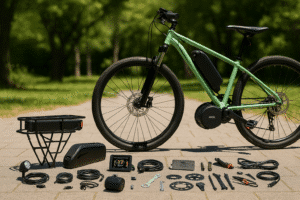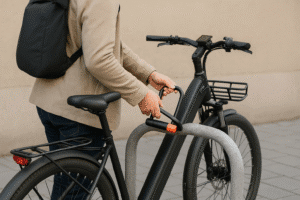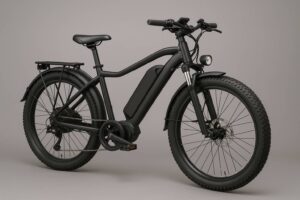Ohio has clear laws that make it easier to ride an electric bike legally. Whether you’re cruising the city or planning a scenic ride, it’s important to understand how Ohio classifies e-bikes, where you’re allowed to ride, and what rules you need to follow.
Here’s what every rider should know in 2025.
Ohio E-Bike Laws at a Glance
- Ohio classifies e-bikes into Class 1, 2, and 3.
- Class 1 and 2 are allowed on most bike paths; Class 3 is limited to paths next to roads.
- No license, registration, or insurance is required.
- Helmets are only required for Class 3 riders.
- You must be 16 or older to ride a Class 3 e-bike.
- Local rules may apply, so check before you ride.
What Counts as an Electric Bike in Ohio?
In Ohio, an electric bike is defined as a bicycle with operable pedals and an electric motor of no more than 750 watts. It must fall into one of the three official e-bike classes based on how the motor works and its speed limit.
This means your e-bike needs to look and function like a traditional bicycle, not a motorcycle or moped. If the motor is too powerful or it doesn’t have pedals, it’s not considered an e-bike under state law.
Ohio follows a three-tier classification system, which is helpful for both enforcement and riders trying to follow the rules. This also keeps things safer on roads, bike paths, and trails.
Ohio’s E-Bike Classes Explained
Ohio uses a three-class system to categorize e-bikes by speed and how the motor operates.
| Class | Motor Type | Max Speed | Pedal Required | Throttle Allowed | Path Access | Min Age | Helmet Required |
| 1 | Pedal-assist only | 20 mph | Yes | No | Allowed on bike/shared-use paths | No | No |
| 2 | Pedal + throttle | 20 mph | No | Yes | Allowed on bike/shared-use paths (some local restrictions) | No | No |
| 3 | Pedal-assist only | 28 mph | Yes | No | Allowed only on paths next to roads | 16+ | Yes |
Where Can You Ride an E-Bike in Ohio?
You can ride Class 1 and Class 2 e-bikes on bike lanes and shared-use paths. Class 3 e-bikes are only allowed on paths that run alongside roads.
These access rules help balance safety and convenience. Local governments may adjust these rules depending on city layout or trail conditions.
Some quick pointers:
- Class 1 and 2: Allowed on most bike paths and multi-use trails
- Class 3: Only allowed on bike paths next to streets or highways
- Local rules override state law, always check with your city or park system
- All classes can ride on public roads, following normal traffic laws
Are E-Bikes Allowed on Trails, Parks, or Sidewalks?
Ohio bans e-bikes from natural surface trails meant for hiking, horseback riding, or mountain biking unless a local agency says otherwise.
You can ride on paved or multi-use trails if you’re using a Class 1 or 2 e-bike, but natural trails are usually off-limits. Class 3 bikes are more restricted, especially in parks and recreational areas.
Sidewalk riding depends on how you’re using the motor. If the motor is off and you’re pedaling manually, some areas allow it. But many cities ban motorized use on sidewalks altogether. Always look for posted signs or city-specific rules.
For example, Ohio Revised Code § 4511.522 explains that motorized scooters and similar devices can only be used on roads under 45 mph and must follow bicycle traffic laws. While e-bikes are a separate category, the principle is the same; rules may vary by vehicle type and location.
Age Restrictions for E-Bikes in Ohio
You must be at least 16 years old to ride a Class 3 e-bike in Ohio. There are no age limits for Class 1 and Class 2 e-bikes.
This rule helps keep higher-speed bikes in the hands of more experienced riders. Younger riders can still ride as passengers on a Class 3 bike, but only if the bike is designed to carry two people.
It’s always a good idea for kids riding lower-class e-bikes to be supervised and wear proper safety gear, even when not legally required.
Do You Need a License or Insurance to Ride?
No, you don’t need a driver’s license, vehicle registration, or insurance to ride an e-bike in Ohio.
Electric bikes are treated like traditional bicycles under state law, not motor vehicles. That means you can ride legally without having to go through the DMV. This makes e-bikes a much more accessible option for people of all ages, especially those who don’t drive.
That said, while insurance isn’t required, some riders choose to get e-bike insurance for peace of mind. It can help cover things like accidents, theft, or damage, especially if you use your e-bike daily or ride in traffic-heavy areas.
Do You Have to Wear a Helmet?
Helmets are required by law for anyone riding a Class 3 e-bike in Ohio. They’re not mandatory for Class 1 or Class 2 riders.
That said, just because it’s not required doesn’t mean it’s not a good idea. Whether you’re a new rider or an experienced commuter, wearing a helmet can protect you from serious injury.
Some cities may also have their own helmet laws for younger riders or specific trails, so it’s always smart to double-check.
Rules of the Road for E-Bikes in Ohio
E-bike riders must follow the same rules as traditional cyclists when using public roads.
Here’s what that means in practice:
- Obey all traffic signals, stop signs, and right-of-way laws
- Ride in the same direction as traffic
- Use bike lanes when available
- Signal turns and lane changes with hand signals
- Use lights at night (front white light, rear red reflector or light)
- Yield to pedestrians when using shared paths or crosswalks
Local Ordinances You Should Know About
While Ohio has statewide laws for electric bikes, local governments have the final say on how those rules apply in their area. Cities, counties, and park systems can all set additional restrictions, especially when it comes to trail access or sidewalk use.
For example, some towns may ban Class 2 or Class 3 e-bikes from certain bike paths. Others may require helmets for all riders, regardless of age or e-bike class. Parks may also limit which trails you can access, particularly those meant for hiking or horseback riding.
Before heading out, it’s always worth checking your city or park district’s website. What’s allowed in Columbus might not be okay in a smaller town or protected parkland.
Micromobility Devices vs E-Bikes: What’s the Difference?
Micromobility devices like scooters are not the same as electric bikes, and they follow different rules under Ohio law.
E-bikes have pedals and are legally treated like bicycles. Devices like e-scooters or hoverboards typically don’t have pedals and are considered separate vehicles. These often fall under Ohio Revised Code § 4511.522, which sets limits on where they can be used.
For example, low-speed scooters may only be used on roads with speed limits under 45 mph and must follow bicycle traffic laws. They can’t be ridden on highways or sidewalks unless local laws allow it.
While e-bikes share some of these rules, the key difference is how the vehicle is powered and operated, and that affects how it’s regulated.
Quick Tips for Riding Legally and Safely in Ohio
Want to keep your ride legal and stress-free? Here are a few simple things to remember:
- Know your e-bike’s class before hitting the road
- Don’t ride Class 3 bikes on bike paths unless next to a road
- Use front and rear lights if riding at night
- Always yield to pedestrians and ride respectfully
- Wear a helmet, especially on Class 3 bikes
- Follow local rules and signs, even if state law allows it
- Keep your bike maintained and brakes in good shape
- Avoid carrying passengers unless your bike is designed for it
Read more:
Final Words
Ohio has clear and rider-friendly laws when it comes to electric bikes. The three-class system helps define where and how each type of e-bike can be used.
Class 1 and 2 bikes are widely accepted on bike lanes and shared paths, while Class 3 bikes come with more restrictions, especially around speed and trail use.
There’s no need for a license, insurance, or registration, which makes riding more accessible. However, don’t forget that local rules can override state law, so always check before heading out.
Whether you’re commuting, exploring trails, or just cruising around town, knowing the rules will help you stay safe and legal on the road.
FAQs
Are electric bikes street legal in Ohio?
Yes, electric bikes are street legal in Ohio. They can be ridden on public roads as long as they have operable pedals and a motor under 750 watts. Riders must follow the same traffic laws as bicycles.
Can I ride a Class 3 e-bike on a bike trail in Ohio?
Only if the trail is next to a road. Class 3 e-bikes are not allowed on standard bike paths unless a local law allows it or the path runs alongside a highway.
Do I need insurance for an e-bike in Ohio?
No, insurance is not required to ride an e-bike in Ohio. However, some riders choose optional coverage for theft or accidents.
Can kids ride e-bikes in Ohio?
Yes, kids can ride Class 1 and Class 2 e-bikes. Riders must be at least 16 to operate a Class 3 e-bike, though younger passengers are allowed.
Do e-bikes need to be registered in Ohio?
No, e-bikes don’t need to be registered or titled in Ohio. They’re treated like regular bicycles, not motor vehicles.
Al Amin Morshed is the founder of BoltBikers and a seasoned e-bike reviewer with years of hands-on experience testing electric bikes. As a long-time e-bike enthusiast, he combines real-world riding insights with in-depth research to create honest, helpful content for riders of all levels. Through BoltBikers, Morshed aims to make e-biking more accessible, practical, and enjoyable – whether you’re a new rider or a daily commuter looking for the best gear.








